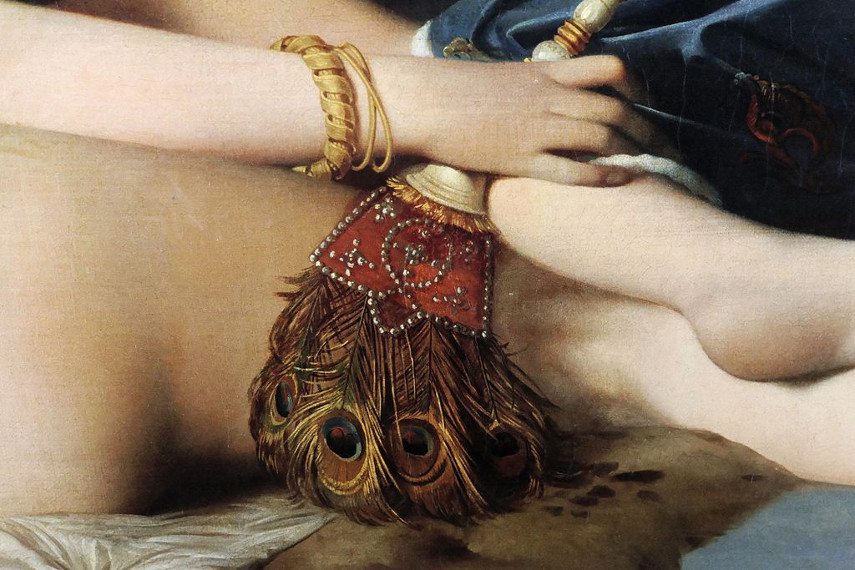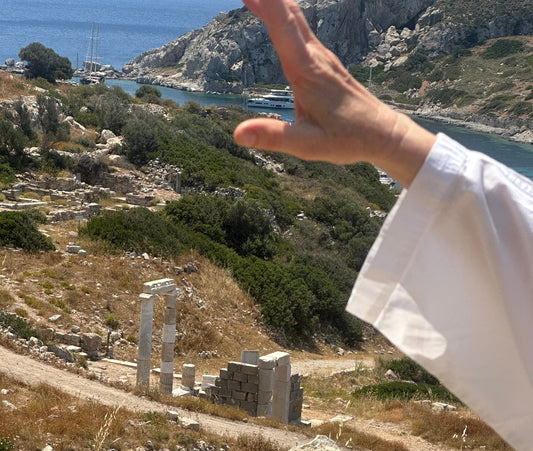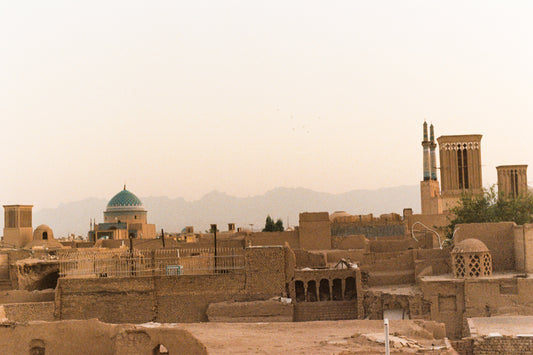On an afternoon in late October, after hours spent sifting through textiles in a shop tucked away on the rooftop of a Han (outdoor courtyard) in the Covered Bazaar of Istanbul, the muezzin’s second call to prayer comes drifting through. It is the first indication of the passage of time. The little-visited Han, once a caravansary stop for traveling merchants, feels like a well-kept secret: one must clamber up uneven cement stairs, dodging overgrown vines, and through a narrow passageway to reach it. A respite from the hustle and bustle of the indoor market, it’s a peaceful time warp, and one of LEVANT’s regular Bazaar haunts.
Stairways leading to the Iç Cebeci Han.
A dusty alley in the Iç Cebeci Han.
One’s first excursion to the Kapali Çarsi – Istanbul’s ‘Covered Bazaar’ – can be an overwhelming visual and sensory experience: cajoling merchants selling leather and jewels, artifacts and icons peeking out of dusty corners, piles of carpets at every turn. The rhythmic sound of backgammon dice hitting the board intercuts with the humdrum of business deals, which can turn strident on the gold trading alleyways. To walk through the Bazaar’s vast, labyrinth-like alleys once, twice or even thrice is to just barely scratch the surface of its wonders and offerings. For LEVANT, the Bazaar is a destination for sourcing inspiration, but more often than not, for getting lost in its quirks and treasures.
While we hesitate to reveal our secrets... here is a selection of LEVANT’s favorite spots; some hidden, a few that may be overlooked to the untrained eye, and several not-to-be missed classics.
A Vestige from the 19th century: Epoque Antiques
The legendary Epoque storefront.
Off of the main Gold Street, the antique store, Epoque, recalls the faded glamor of 19th century decor. Inside you will find eclectic wares, from high-end antiques and artfully draped tapestries, to semi-precious stones and Byzantine icons. The shopkeeper who regularly manages the store is a knowledgeable guardian for its true owner: an Armenian gentleman whose family has owned the store for decades.
Russian and Byzantine icons on display.
The Armenian Silver Engravers: SEVAN
Armenians have a reputation for being master metalworks and jewelers, and Sevan is no different; his family has been in the engraving and diamond setting business since the 1940’s, and his shop is one of the last in the Bazaar that still engraves silver by hand.
A vitrine of family heirlooms and stories, silver rings, and odds and ends.
Sevan is one of the last hand-engravers of silver in the Bazaar.
Sevan's father, who opened his silver shop in 1955.
The outside vitrine of his shop has a hand-drawn map of the Middle East, alongside family photos of his father from 1960s Istanbul. Inside his pea-sized shop, you’ll find vintage photographs, newspaper clippings, and Christian iconography. Whether or not you have a silver piece ready to be engraved, stop in for a tea at Sevan’s to be regaled with stories of the Bazaar, past and present.
Off-the-beaten-path textiles: Engin Tekstil
Engin Tekstil, at the end of what LEVANT dubs 'Textile Way'.
A purveyor of pashminas, peshtemals, silks, and assorted fabrics by the meter, Suleyman Ertas of Engin Tekstil, has also been known to provide the costumes for Hollywood movies, popular Ottoman-era TV shows, and even Game of thrones. You’ll find Engin Tekstil right before the exit at the end of a long row of shops we dubbed “Textile Way.”
On the lower level of Engin's shop you will find Turkish costumes, made for movies and soap operas.
Woven ribbons from Uzbekistan.
Master Jeweler: Selçuk Ipek
Mention Selçuk Ipek’s name at any Bazaar stall and merchants acknowledge his talent and eye for jewelry. From resetting vintage jewelry to custom designing a piece of your imaginings to his vast array of semi-precious and precious stones, Selçuk is a fixture of the “Old bazaar”, the section of the market known for its antiques. When we were last in his store, he taught us about stone inclusions and the difference between tourmalines and rubellites, which he calls the Queen of its gemstone family.
Selçuk Ipek's store in the Old Bazaar.
Serenity of the Hans: Iç Cebeci Han
While the outdoor Hans have much to service both art lovers and shoppers, from antique suzanis to traditional pearl-inlaid harem slippers to copper wares, they also offer a welcome interlude to a day spent in the Bazaar. On the bottom floor of Iç Cebeci Han, we like to stop for a soup and chicken shish with chopped salad and white cheese, before climbing up to the rooftop and spending time visiting our favorite stores.
LEVANT founders Süreya and Naz, at lunch in the Iç Cebeci han's lower courtyard.
Iç Cebeci lower han covered in vines.
On the rooftop of the Iç Cebebi Han, a space of flickering light and shadow, the sound of tapping hammers echo across the courtyard. Up here, you will find traditional copper smiths molding their wares – gleaming trays, elegant coffee pots, and crescent moons – or sitting outside sipping on turkish tea which has been ferried up from downstairs. Several of them still produce in the classical Ottoman style of 16th century tombak, copper ware which is coated with a mixture of gold and mercury.
A metal work studio, where Ottoman technique 'tombak' is still produced.
A metal shop in the Iç Cebeci han.
An artisan at work on copper.
The other side of the courtyard, accessed by an outside alleyway, is home to textile stores selling antique and contemporary suzanis, as well as Ottoman-era fabrics. The facade of LEVANT’S favorite store bears no name, but it’s recognizable by its canopy of zesty green vines and the flapping kaftans flanking its entrance.
Ulas says 'make a mess', and we often do!
Inside, you will find stacks piled high of richly textured fabrics from Uzbekistan, Turkey, and the provinces of the former Ottoman Empire. Many of the pieces are hand loomed and hand-embroidered. Ulas, the hospitable proprietor, will welcome you in and invite you to “make a mess.” While present for the all important questions of provenance or price, he never hovers, and often you will find yourself alone with a heap of fabrics. If you manage to find him, tell him Sureya and Naz say “hi”.
A Classic Outpost: Fes Cafe
Fes Cafe sits just outside the Bazaar, by the Nuruosmaniye Gate.
Hand-dyed textiles and peshtemals in Metin's shop.
The cobblestone street leading up to the Nuruosmaniye Gate of the Covered Bazaar used to house 24 karat gold jewelers of great distinction, as well as carpet and antique dealers. While many have left for more fashionable areas of Istanbul, there is a cafe-cum-store that merits distinction. To sit in Fes cafe is to inhabit the eclectic flair of its owner, Metin Tosun, who began his career as an apprentice to a carpet seller inside the Bazaar. Over a jazz soundtrack, you can have a light salad or sandwich, sip on a Turkish tea, or have a cold glass of Rose from a home-grown winery in Assos, an island off of the Aegean coast. Amongst hand-carved soap sculptures, ceramic pieces, leathers, and other odds and ends, you’ll find an impressive collection of textiles. Metin has both antique pieces and organic, hand-dyed textiles of various textures and materials for sale in his shop corner.
LEVANT wishes you happy discoveries!




























